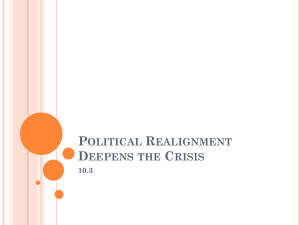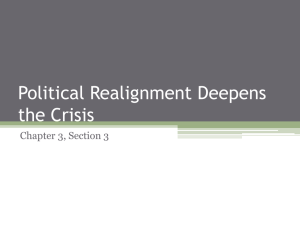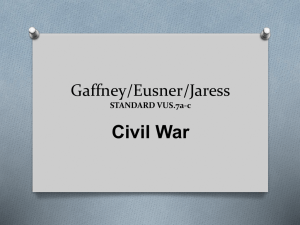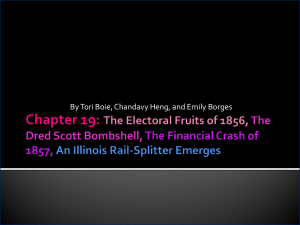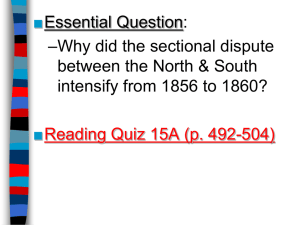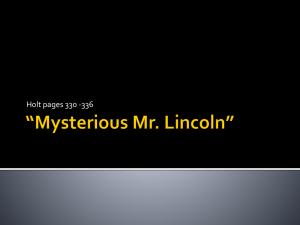File
advertisement
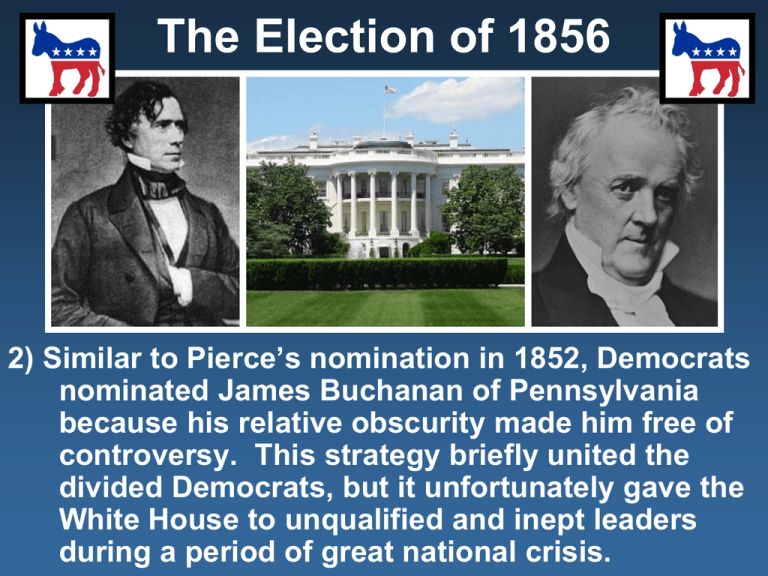
The Election of 1856 2) Similar to Pierce’s nomination in 1852, Democrats nominated James Buchanan of Pennsylvania because his relative obscurity made him free of controversy. This strategy briefly united the divided Democrats, but it unfortunately gave the White House to unqualified and inept leaders during a period of great national crisis. The Election of 1856 Northern Whigs Free Soilers 3) The controversy of the Kansas Nebraska Act and the events of Bleeding Kansas united northern Whigs, FreeSoilers, and abolitionists under the banner of the new Republican Party. The Republicans nominated General John C. Fremont, the “Pathfinder” of the MexicanAmerican War. The Republican platform called for the non-extension of slavery and the Democrats declared their support for the doctrine of “Popular Sovereignty.” The Election of 1856 Fillmore 4) A nativist (anti-immigrant) faction of the Whigs formed the Know-Nothing Party in order to organize Protestant opposition to the influx of Catholics that immigrated to northern cities from Germany and Ireland. The KnowNothings nominated ex-President Millard Fillmore. The small third party mostly helped Buchanan and Democrats into the White House by taking northern votes away from the Republicans. John C. Fremont (R) = Millard Fillmore (K-N) James Buchanan (D) The Dred Scott Decision 1) Dred Scott was a black slave that was owned by Dr. David Emerson, a surgeon in the U.S. Army. During the 1830s, Dr. Emerson was stationed at northern forts in Illinois and the Wisconsin Territory. Despite Emerson’s move to free territory, Dred Scott accompanied his master and was hired out to work for local farmers. The Dred Scott Decision 2) After living in free territory for five years, Dr. Emerson sent for Scott to join him in slave-holding Missouri. Scott obeyed and returned south with his new wife and children to join his master in St. Louis. In 1843, Dr. Emerson unexpectedly died and his widow, Irene Emerson continued to rent out the labor of Dred Scott for the next three years. In 1846, Dred Scott tried to purchase his freedom, but Mrs. Emerson refused. The Dred Scott Decision Missouri Supreme Court 3) Scott sued the widow Emerson on the basis that his previous residence in free territory in Illinois and Wisconsin constituted his emancipation as a slave. A Missouri court sided with Dred Scott, but the widow Emerson successfully appealed the case to the state Supreme Court that reversed the decision. The Dred Scott Decision 4) With the help of wealthy abolitionists, Dred Scott’s case was appealed before the U.S. Supreme Court. Under the leadership of Chief Justice Roger B. Taney of slave-holding Maryland, the Supreme Court ruled that Dred Scott was a slave and not a citizen, and therefore did not posses the right to sue. The Dred Scott Decision 5) Chief Justice Taney wrote, “beings of an inferior order, and altogether unfit to associate with the white race, either in social or political relations, and so far inferior that they [have] no rights which [a] white man [is] bound to respect.” The Dred Scott Decision 6) Taney could have simply dismissed the case on the technicality of Scott’s citizenship, but the southern majority on the Court attempted to use the case to ensure future legal protection for the institution of slavery. The Dred Scott Decision 5th 7) In addition to denying Dred Scott’s citizenship and legal rights, the Supreme Court specifically identified slaves as private property that fell under the protection of the 5th Amendment. Because the 5th Amendment specifically prohibits Congress from denying the right of private property, the ruling denied Congress of its power to regulate slavery. The Dred Scott Decision 8) Under the Dred Scott decision, slaves could be taken into any territory and legally held there in slavery. This earth-shattering precedent suggested that all previous laws that banned slavery were unconstitutional. The Dred Scott Decision 9) The Dred Scott decision emphatically declared that slavery could not legally be banned anywhere. Southerners celebrated the decision as a great victory and some extremists believed that it reopened the possibility that slavery could spread into the territories. Southerners were confident that the ruling represented an irreversible legal protection for their “peculiar institution.” The Dred Scott Decision 12) “Free-soil” Republicans were infuriated by the decision and were further convinced that there was a southern conspiracy to extend slavery. Northern Democrats also stood in opposition to the decision and continued to support the “Popular Sovereignty” doctrine of Senator Stephen A. Douglas. The Dred Scott Decision 13) In 1858, the Republican Party nominated Abraham Lincoln to challenge incumbent Stephen A. Douglas for his Illinois Senate seat. Upon accepting his party’s nomination, Lincoln delivered his historic “House Divided” speech in Springfield, Illinois. The Dred Scott Decision 14) Lincoln declared, “A house divided against itself cannot stand. I believe this government cannot endure, permanently half slave and half free. I do not expect the Union to be dissolved — I do not expect the house to fall — but I do expect it will cease to be divided. It will become all one thing or all the other.” The Lincoln-Douglas Debates 1) Abraham Lincoln was born to a poor frontier family in a Kentucky log cabin in 1809. Reflecting his pioneering background, a young Lincoln was employed as a log splitter for fence rails. In spite of his rough environment, Lincoln proved to be an industrious youth with an unquenchable thirst for knowledge. Replica of Lincoln family home in Hodgenville, Kentucky The Lincoln-Douglas Debates 5) Lincoln earned a reputation for strongly opposing slavery and quickly rose to prominence within the new Republican Party. Lincoln was one of the top choices for Vice-President on the ticket with John C. Fremont in the election of 1856. The Lincoln-Douglas Debates 6) As mandated by the original Constitution, the Senators from each state were still elected by the members of the state legislature. Despite a limited electorate, the 1858 Illinois Senate race attracted widespread national attention because it represented a decisive battle over slavery and the doctrine of popular sovereignty. The Lincoln-Douglas Debates 7) The implications of the 1857 Dred Scott decision gave added weight to Lincoln’s challenge to Democrat Stephen A. Douglas and his Illinois Senate seat. In an attempt to sway northern support away from the Democrats, Lincoln daringly challenged Douglas to a series of debates. The Lincoln-Douglas Debates 8) Known for his stunning oratorical skills, Douglas eagerly accepted the challenge from his Republican opponent. The lanky “rail-splitter” faced off against the stout “Little Giant” in a series of seven debates from August – October 1858. The Lincoln-Douglas Debates 9) All seven debates largely centered around the issue of slavery. Douglass accused Lincoln of being an abolitionist and he criticized him for suggesting that the Declaration of Independence also applied to blacks. Lincoln criticized the Kansas-Nebraska Act, blamed Douglas for Bleeding Kansas, and asserted that “popular sovereignty” was an attempt to extend and nationalize slavery. The Lincoln-Douglas Debates 12) Douglas was able to exploit racist anxieties in Illinois in order to defeat Lincoln. Illinois was a free-soil state that had banned free blacks from settling within its borders. In one debate Douglas declared, “If you desire negro citizenship, if you desire to allow them to come into the State and settle with the white man, if you desire them to vote on an equality with yourselves…then support Mr. Lincoln and the Black Republican party, who are in favor of the citizenship of the negro. For one, I am opposed to negro citizenship in any and every form. I believe this Government was made on the white basis.” The Lincoln-Douglas Debates 13) Northern Democrats retained control of the state legislature in Illinois, enabling Douglas to defeat Lincoln in the Senate race. However, the Lincoln-Douglas debates gained national attention and came to represent the intense national debate concerning slavery. The Election of 1860 N S 1) The election of 1860 revealed that the Democratic Party was hopelessly divided between bitter sectional factions. When northern Democrats tried to nominate Illinois Senator Stephen A. Douglas at the party’s National Convention in Charleston, South Carolina, angry southern delegates refused to accept his “Freeport Doctrine” on popular sovereignty and walked out in protest. The Election of 1860 2) Southern Democrats later held their own convention in Baltimore, Maryland and nominated John C. Breckinridge from slave-holding Kentucky. The southern faction of the party adopted a platform that supported the Dred Scott decision of 1857. The Election of 1860 4) The Republican National Convention in Chicago, Illinois seemed ready to nominate New York Senator William H. Seward, but his abolitionist reputation and his remarks describing slavery as an “irrepressible conflict” made him far too controversial. Abraham Lincoln’s moderate politics and his proven commitment to “free-soil” earned him the party’s nomination for President. The Election of 1860 5) The Republicans offered a very broad platform that exclusively appealed to various groups of northerners: A) Non-extension of slavery = abolitionists and free-soilers B) A protective tariff = northeastern industrialists C) A transcontinental railroad = for northwesterners D) Federally-funded internal improvements = for westerners E) Free western homesteads from public land = for western pioneers (The Homestead Act) The Election of 1860 6) The Republican Party was able to take advantage of their divided opponents in order dominate the populous free states of the North. The Republican Party made no attempt to campaign in the South and Lincoln’s name wasn’t even allowed on the ballot in ten southern states. N-DEM S-DEM - = The Election of 1860 7) Lincoln captured only 40% of the popular vote, but won a majority of the electoral college by winning the more populous states in the north. As a purely sectional candidate that voiced moral opposition to slavery, Lincoln’s election inevitably caused southern opposition. The Election of 1860 8) Four days after the election of Lincoln, the South Carolina legislature voted unanimously to call for a special state convention. They met in December of 1860 and they voted unanimously to secede from the Union. In the next six weeks, Alabama, Mississippi, Florida, Georgia, Louisiana, and Texas voted to join the South Carolinians. The Election of 1860 9) Delegates from these “Deep South” states met in Montgomery, Alabama in February 1861 and formed the Confederate States of America. They elected former Senator Jefferson Davis of Mississippi as their President. Secession 1) The eleven states of the southern Confederacy felt compelled to secede from the Union because of several sectional disputes, but most were directly related to states’ rights and slavery. Secession 3) The South believed that it was economically superior to the North and many thought that secession was their chance to finally become self sufficient. The South desperately wanted to establish an independent banking system, lower tariff rates, and direct free trade with Europe – All were prevented by the protections that had previously been reserved for northeastern industry. Secession 4) Many Southerners believed that secession represented a second American Revolution. Just as they had done in 1776, Southerners believed that they were declaring their independence from northern oppressions and tyranny. Secession 5) The thirteen colonies voluntarily established the Union by ratifying the Constitution in 1789. Many Founding Fathers intended the Union to be a permanent institution, but the Constitution remained silent concerning the act of secession. Southerners believed that the Union established by the Constitution was a voluntary compact and they felt that secession was necessary in order to protect their political rights.
